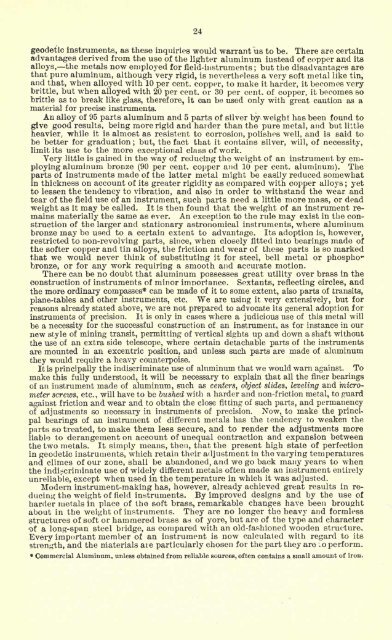STANDARD - Survey Instrument Antique Center!
STANDARD - Survey Instrument Antique Center!
STANDARD - Survey Instrument Antique Center!
You also want an ePaper? Increase the reach of your titles
YUMPU automatically turns print PDFs into web optimized ePapers that Google loves.
24<br />
geodetic instruments, as these inquiries would warrant us to be. There are certain<br />
advantages derived from the use of the lighter aluminum instead of copper and its<br />
alloys, the metals now employed for field-instruments ; but the disadvantages are<br />
that pure aluminum, although very rigid, is nevertheless a very soft metal like tin,<br />
and that, when alloyed with 10 per cent, copper, to make it harder, it becomes very<br />
brittle, but when alloyed with 20 per cent, or 30 per cent, of copper, it becomes so<br />
brittle as to break like glass, therefore, it can be used only with great caution as a<br />
material for precise instruments.<br />
An alloy of 95 parts aluminum and 5 parts of silver by- weight has been found to<br />
give good results, being more rigid and harder than the pure metal, and but little<br />
heavier, while it is almost as resistent to corrosion, polishes well, and is said to<br />
be better for graduation ; but, the fact that it contains silver, will, of necessity,<br />
limit its use to the more exceptional class of work.<br />
Very little is gained in the way of reducing the weight of an instrument by employing<br />
aluminum bronze (90 per cent, copper and 10 per cent, aluminum). The<br />
parts of instruments made of the latter metal might be easily reduced somewhat<br />
in thickness on account of its greater rigidity as compared with copper alloys ; yet<br />
to lessen the tendency to vibration, and also in order to withstand the wear and<br />
tear of the field use of an instrument, such parts need a little more mass, or dead<br />
weight as it may be called. It is then found that the weight of an instrument remains<br />
materially the same as ever. An exception to the rule may exist in the construction<br />
of the larger and stationary astronomical instruments, where aluminum<br />
bronze may be used to a certain extent to advantage. Its adoption is, however,<br />
restricted to non-revolving parts, since, when closely fitted into bearings made of<br />
the softer copper and tin alloys, the friction and wear of these parts is so marked<br />
that we would never think of substituting it for steel, bell metal or phospho**<br />
bronze, or for any work requiring a smooth and accurate motion.<br />
There can be no doubt that aluminum possesses great utility over brass in the<br />
construction of instruments of minor importance. Sextants, reflecting circles, and<br />
the more ordinary compasses* can be made of it to some extent, also parts of transits,<br />
plane-tables and other instruments, etc. We are using it very extensively, but for<br />
reasons already stated above, we are not prepared to advocate its general adoption for<br />
instruments of precision. It is only in cases where a judicious use of this metal will<br />
be a necessity for the successful construction of an instrument, as for instance in our<br />
new style of mining transit, permitting of vertical sights up and down a shaft without<br />
the use of an extra side telescope, where certain detachable parts of the instruments<br />
are mounted in an excentric position, and unless such parts are made of aluminum<br />
they would require a heavy counterpoise.<br />
It is principally the indiscriminate use of aluminum that we would warn against. To<br />
make this fully understood, it will be necessary to explain that all the finer bearings<br />
of an instrument made of aluminum, such as centers, object slides, leveling and micrometer<br />
screws, etc., will have to be bushed with a harder and non-friction metal, to guard<br />
against friction and wear and to obtain the close fitting of such parts, and permanency<br />
of adjustments so necessary in instruments of precision. Now, to make the principal<br />
bearings of an instrument of different metals has the tendency to weaken the<br />
parts so treated, to make them less secure, and to render the adjustments more<br />
liable to derangement on account of unequal contraction and expansion between<br />
the two metals. It simply means, then, that the present high state of perfection<br />
in geodetic instruments, which retain their adjustment in the varying temperatures<br />
and climes of our zone, shall be abandoned, and we go back many years to when<br />
the indiscriminate use of widely different metals often made an instrument entirely<br />
unreliable, except when used in the temperature in which it was adjusted.<br />
Modern instrument-making has, however, already achieved great results in reducing<br />
the weight of field instruments. By improved designs and by the use of<br />
harder metals in place of the soft brass, remarkable changes have been brought<br />
about in the weight of instruments. They are no longer the heavy and formless<br />
structures of soft or hammered brass as of yore, but are of the type and character<br />
of a long-span steel bridge, as compared with an old-fashioned wooden structure.<br />
Every important member of an instrument is now calculated with regard to its<br />
strength, and the materials aie particularly chosen for the part they are 10 perform.<br />
Commercial Aluminum, unless obtained from reliable sources, often contains a small amount of iron.


